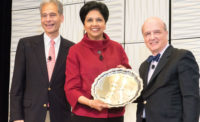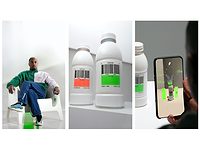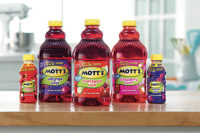Beverage and Retail Innovation
Retail analyst issues industry challenge in 2008
A new year brings with it
the opportunity for a new outlook. Beverage
Industry spoke with Thom Blischok,
president of retail solutions North America and strategic solutions for
Information Resources Inc., Chicago, to delve into his expertise and gather
a few 2008 predictions for the beverage category. Blischok shared his
insights on the segment’s need to innovate and how those innovations
will impact retail.
Beverage Industry: What
challenges do you currently see in the beverage industry?
Thom Blischok: There are four trends I see as critical in the beverage
industry. The first is that gas prices will start to impact consumption.
Consumption-wise, we are beginning to see consumers going back to the
basics as gas prices increase. With this in mind, the beverage industry
needs to have a very precise focus on what changes are occurring in
consumer behavior.
Second, there has been a growing drumbeat for what
I’ll term “better-for-you” products. In the past, consumers simply bought something to drink without
considering how that product fit into their overall personal approach to
healthy consuming. Now these same consumers are viewing the value of their
beverage choice through a healthy eating and drinking lens and are
questioning whether they want to drink it at all.
Third, is the issue of sustainability — the
effort to weigh the environmental impact and labor circumstances that bring
individual products to market. Whether the issue is organic food,
eco-friendly packaging or Fair Trade practices, figuring out how to deal
with these evolving green issues will become a true challenge for
companies.
Fourth is the need to innovate. People want new and
innovative ways to drink things. The winning approach will be the one that
provides a fresh look, approach and attitude to beverages.
BI: Hybrid products seem
to be a new direction for the industry. Do you think that is a worthwhile
innovation?
TB: First, it’s
important to recognize that there has been a major shift from premium
brands to functional brands in the marketplace. Consumers are wondering,
“How do I make what I put in my body better for me?” They are
beginning to understand wellness from the outside and wellness from the
inside. So instead of taking a vitamin with water, “Why don’t I
drink water that has vitamins in it?”
Manufacturers and retailers are beginning to address
this new brand of thinking with some very innovative products. And
there’s a real up-side to this new approach. Some of the single
biggest hybrid functional brands are redefining support by thinking about
dietary management and personal health needs, such as providing solutions
for the consumer who wonders, “What should I drink to address my
diabetic condition?”
BI: Are there any beverage
categories you think are not innovating enough or well enough?
TB: I don’t think
“not innovative enough” is the proper terminology. But, yes, I
am certain there are some examples in the category of underachievement to
date. However, the real news in beverages is the innovations that are
taking place, including the fact that we are on the cusp of the next wave
of innovative functional waters. I also think there will be an evolution in
providing different levels of packaging as consumers become more concerned
with dietary and diabetic control, which basically means portion control. I
also expect a range of new packaging of 100-calorie beers and other
100-calorie flavored beverages. They will be smaller portions, but will
remind consumers of the overall mission or strategy to extend their life.
And [the focus] won’t be a subtle awareness on a product’s
health — it will be a dramatic one.
Another interesting innovation I see is the pairing of
particular beverages with food. Pairings are a very important strategy for
the positioning of drinks, removing them from the traditional presentation
of them as just a commodity. Examples can be seen in how consumers are
expanding their knowledge of how certain wines work with specific spices or
how beer flavors are a complement to specific food.
I think we’ll see an increasing sophistication
of beers and wines at retailers. There may be some retailers who begin
stocking wine at 55 degrees, which is the optimum temperature for wine
storage. This will appeal to “wine-o-philes” who will recognize
the retailers’ understanding of their own sophistication.
BI: As
consumers’ shopping habits change, what can beverage companies do to
keep their brands top of mind?
TB: There are three
things that are fundamental, in my opinion. First, beverage companies need
to begin to understand the changing shape of thirst. If they are marketing
to boomers, they should understand that the Roosevelt boomers, who are 60
years old and above, are “wine-o-philes;” Truman boomers are
beer drinkers; and Kennedy boomers have a less precise preference of wine
or beer based on their local environment. And they are just one example of
the ongoing landscape and changing perspective of thirst.
Second, retailers themselves need to remind people
that beverages can be functionally driven. They can merchandise beverages
based on the quality of the beverage. For example, you can bundle purchases
of coffee with bottled water, so you have hot-to-go and cold-to-go.
Third, is packaging innovations, which could mean
beverages that are self-heating, self-chilling or converting a package to
be visually open to show what the product is. This could mean beer
packaging in clear glass. Beer used to deteriorate faster in clear
packaging, but now there are packaging micro-technologies that will advance
the freshness. Following on the strength of the popularity of antioxidants,
packaging will have to tell the story of how the product is better for you
and why.
BI: Within retail, do
you think there are flaws in the current approach to beverage retailing?
TB: I see trends in
retailing that I believe are based on history and not moving forward. The
current strategy is stacking [products] wide and high to get as many
flavors and products in the store as possible. The plus side of that is you
have multiple variations. The minus is that there are so many variations
that it blurs the consumer’s focus and creates some uncertainty on
what they should buy.
I think the future is in a beverage center
that’s divided by physical displays to help solve the thirst
challenge for families. The beverage center could be organized by green or
non-green concerns or by diabetic needs. It would be the beginning of an
assemblage of a story on why beverages are better for you. Packaging and
displays will also remind shoppers to buy other pieces or classes of
product. Grocery stores need to make a clear statement for diabetic
consumers, the person on the go, or quick-trip shoppers. The displays need
to find ways to actively tell me what I’m buying vs. just passively
buying a product. If you look at [office supply store] Staples, their paper
wall tells you what the paper is for.
In the beverage aisle, there are some chains that are
categorizing wines for chicken and fish. Consumers want to know why this is
the right product to buy for a particular meal or occasion. Bridging this
need with clear and organized information will change the retail beverage
experience.
BI: What do you think
is in the future of beverage retailing?
TB: If I had to look
into my crystal ball, I would first say there is a lot of innovation
developing in displays at stores. The display needs to appeal to total
consumption, which is a move away from affinity-based marketing and
retailing. I see this happening by degree, and I think will continue to
gather momentum.
Second, at some point in time I think selling
condensed beverages will increase. Is it feasible for a non-traditional
water manufacturer to take their ingredients and make it in a way that will
fundamentally improve a bottle of water? I think we will be finding that
out in the near future, and I think the answer is yes.
Third, I think there will be an explosion in the
convenience store beverage sections that will turn the convenience store
into a micro-beverage store. It will be a new way of selling and branding
beverages. The possibilities are limitless.


